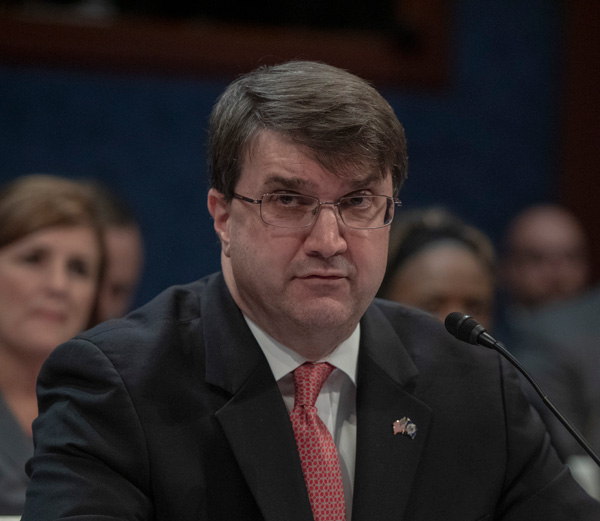Department of Veterans Affairs (VA) Secretary Robert Wilkie, JD, and other VA leaders testified on March 4 before the House Appropriations Subcommittee on Military Construction, Veterans Affairs, and Related Agencies on the president’s fiscal year (FY) 2021 budget proposal for the agency [see Washington Highlights, Feb. 14].
The president’s FY 2021 request includes $787 million for VA research, a $13 million, or 1.6%, decrease below the FY 2020 enacted level. The president’s budget also includes $18.5 billion for VA Medical Community Care, a $3.2 billion (21%) increase over the FY 2020 comparable level, and $20.2 billion in FY 2022 advanced appropriations. The budget request includes $56.7 billion for VA Medical Services in FY 2021, a $5.6 billion (11%) increase from the 2020 enacted level. The budget also proposes $58.9 billion in 2022 advance appropriations for VA Medical Services programs.

Committee Chair Debbie Wasserman Schultz (D-Fla.) opened the hearing by questioning the feasibility of the nearly $13 billion increase for the VA proposed in the president’s FY 2021 budget request, considering the current discretionary spending limits. “In a perfect world without budget caps, this essentially fantasy budget is a wonderful request. We would love to be able to provide veterans with the most care and benefits money can buy,” Rep. Wasserman Schultz said.
She added, “The only way to make the president’s budget work is to get a cap adjustment for the MISSION Act, period.” In later questioning, Sec. Wilkie explained that the rationale for the administration’s opposition to a cap adjustment for MISSION was “above my pay grade.”
Ranking Member John Carter (R-Texas) echoed the concern, noting, “The VA’s proposed 14% increase for discretionary programs would require substantial oversight to say the least.”
In his opening statement, Sec. Wilkie summarized implementation of the MISSION Act, citing that VA provided almost 2 million more clinical appointments within the VA in 2019 than the previous year. VA staff previously testified before the Senate Committee on Veterans Affairs regarding MISSION Act implementation [see Washington Highlights, Feb. 7].
Rep. Wasserman Schultz pressed VA witnesses for more detail on the number of veterans and associated health care costs for veterans receiving care in the community through the MISSION Act’s new Community Care Network. VA Assistant Secretary for Management and Chief Financial Officer Jon Rychalski said the consolidation of VA and non-VA care through the MISSION Act has made it “increasingly difficult” to differentiate those episodes of care.
Sec. Wilkie said paying the 880,000 community partners continues to be a priority for the VA. A new system is helping the VA make payments within three days, but the VA continues to repay the “billions of dollars in payments that were not paid going back almost a decade.”
Rep. John Rutherford (R-Fla.) expressed concern about the recruitment and retention of physicians at VA. Richard Stone, MD, executive in charge at the Veterans Health Administration, told the lawmaker that the VA workforce grew by more than 11,000 in 2019, and over 70% are clinical staff. The FY 2021 budget aims to add more than 7,000 clinical providers. As in previous hearings, Dr. Stone noted the challenges in hiring specialized physicians due to VA’s salary caps.
Committee members also expressed an interest in VA’s response to the novel coronavirus (COVID-19). Rep. Cheri Bustos (D-Ill.) asked about VA’s preparedness and efforts to coordinate with the Department of Health and Human Services. Dr. Stone noted that the VA has been working on preparedness since January and now has one confirmed case in a veteran at the Palo Alto VA. Rep. Wasserman Schultz followed with questions on testing kit availability, to which Dr. Stone said that the VA already has kits and is working in VA clinical centers and with academic partners to build laboratory developed tests at local facilities. Additionally, Sec. Wilkie officially joined the president’s Coronavirus Task Force on March 4.
On VA research, Dr. Stone highlighted VA’s precision oncology work, pointing to an additional request of $75 million to support genomic research emanating from the Million Veteran Program. Dr. Stone said that VA is the largest provider of oncology services in the country, diagnosing 200 new cancer cases each day.
Rep. Wasserman Schultz reminded witnesses of the FY 2020 spending bill language restricting VA’s use of animal models in research [see Washington Highlights, June 28, 2019] and shared her concern about the use of canines in spinal cord injury models. Rep. Wasserman Schultz contended that some universities are conducting spinal cord research without canines, to which Sec. Wilkie and Dr. Stone countered that the VA collaborates with academia in their use of canines to study the unique needs of veterans. However, Rep. Wasserman Schultz was not convinced and indicated the restrictive language would remain in the FY 2021 spending bill.